Lake Ilopango El Salvador is a volcano crater lake located outside the capital city. Ilopango Lake is 72 square kilometers and has a max depth of 248 meters; it borders the San Salvador, Cuscatlan, and La Paz departments.
The Ilopango Lake caldera is one of the most popular and most visited in the country. It is an excellent location for diving, sailing, fishing, and other water activities.
- Tourism
- What to do at Lake Ilopango?
- Scuba Diving in Ilopango
- Taking a Boat Tour
- Swimming
- Enjoying Water Sports
- Visit the Apulo Tourist Center
- Travel the Panoramic Route
- Taste the local gastronomy
- Visit the Ilopango’s Aviation Museum
- Ilopango’s History
- Ilopango Volcano Big Eruption
- Other Eruptions
- An Active Volcano
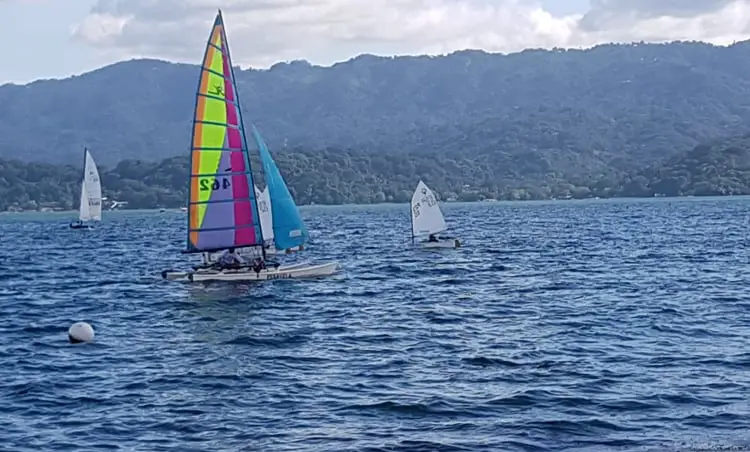
The Lake area is fantastic for spending the day exploring and relaxing with family or friends. The volcanic caldera area has plenty of activities that can be done in a single day.
Before the Lake of Ilopango was formed, there was a volcano called XILOTEPEC. According to historical data, when it erupted, it submerged and gave origin to the now-famous Lake Ilopango.
SEE ALSO: El Salvador’s Ecotourism. 10 Incredible Salvadoran Natural Parks Worth Exploring!
Tourism
Lake Ilopango El Salvador is a top tourist destination. There are plenty of activities available to get done here, from boat rides, jet skis, diving, fishing, kayaking to taking a bath on the shores.
You can also go hiking, horseback riding, camping, or enjoying the panoramic views. There is plenty of tourism at one of the largest lakes in El Salvador.
What to do at Lake Ilopango?
The best things to do at Lake Ilopango are Scuba Diving, taking a boat tour, swimming, playing water sports, and visiting the Apulo tourist center.
Also, traveling the panoramic route and tasting the local gastronomy are popular activities to get done here.
SEE ALSO: El Salvador Tourism: A Journey Through Pristine Beaches, Colorful Towns, and Enchanting Parks
Scuba Diving in Ilopango
Scuba diving is an excellent option at this caldera lake; Ilopango has warm water and exceptional diving locations.
Two of the best diving spots at this lake are the Los Flumeroles and the statue of Christ the Redeemer.
At Los Flumeroles, divers will be able to feel the warm water rising from the active volcano and see the sulfur deposits around the cracks in the lake bed.
Another top diving destination is the statue of Christ the Redeemer, which is near the Los Quemados island. Here, divers will find the submerged figure of Christ the Redeemer that looks just like the one in Brazil.
One important thing to keep in mind is that there is no diving school at the lake. Therefore, if you want to dive in Ilopango lake, you need to make prior diving arrangements.
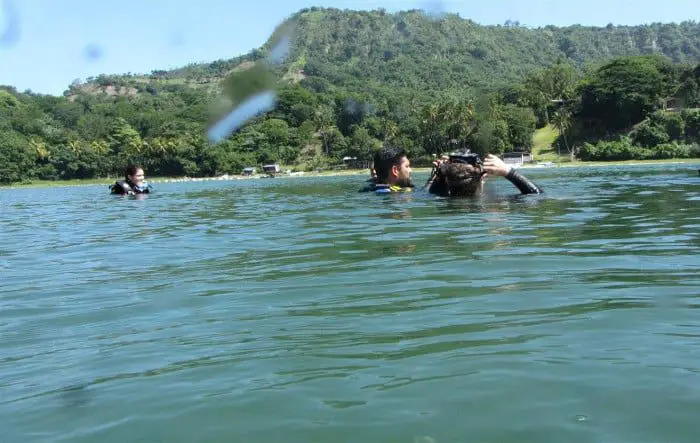
Taking a Boat Tour
Taking a boat tour deep into the lake is a popular activity; boat tours are available from many different points along the shore. The most popular spot to catch a boat is near the Apulo tourist park.
On a boat ride, you can view up close the burnt Islets located in the middle of the lake. Additionally, you can also view the flora and fauna that surround the caldera.
Swimming
Spending a day swimming and relaxing at the lake’s shore is a fun activity to do with family and friends. Visit the main tourist area near the Apulo tourist center or venture into a more isolated area and spend the day swimming in these warm volcanic waters.
Enjoying Water Sports
This volcanic caldera is an ideal spot to spend time enjoying water sports such as sailing, kayaking, jet-skiing, or windsurfing. The warm lake water makes enjoying water sports a top activity at Ilopango.
Visit the Apulo Tourist Center
The Apulo tourist center or recreational park sits on the banks of the lake. The park has 34 cabins, a picnic area, a soccer field, changing rooms, small restaurants, and much more.
Apulo is a popular destination, especially on the weekends and national holidays. If you don’t like crowds, avoid visiting the Apulo park on the weekends; it is best to visit during the weekdays.
Travel the Panoramic Route
Ilopango’s panoramic route is made up of different viewpoints located around the lake. These viewpoints are scattered in the municipalities that surround the crater lake.
This route not only allows visitors to appreciate the beauty of the lake from a panoramic view. But also allows visitors to get to know and view the local culture of small neighboring towns.
Taste the local gastronomy
Enjoying the local traditional Salvadoran foods is another activity worth doing at Lake Ilopango. These restaurants, with spectacular views, serve all types of locals dishes and popular drinks.
Visitors can try the local cuisine at the boardwalk located near the Apulo tourist center. Also, at any of the many restaurants located near the scenic viewpoints on the panoramic tourist route.
Visit the Ilopango’s Aviation Museum
A trip to Ilopango's aviation museum is worth doing. The museum is located at the old international airport, about 8 kilometers from Ilopango lake’s main tourist center.
The museum has 10 rooms and 3 exhibition areas; here, visitors can find the entire historical trajectory of the Salvadoran Air Force.
Throughout the museum, visitors will see aeronautical drawings, military uniforms, scale airplane models, helicopter cabins, and airplanes used during different times in El Salvador.
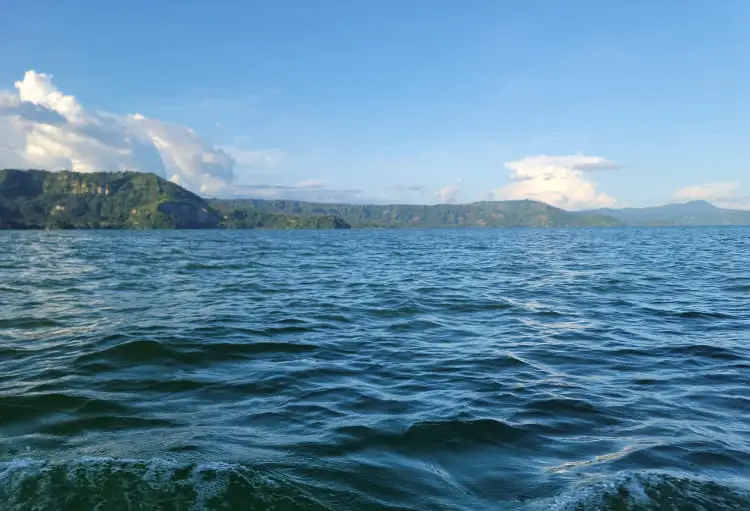
Ilopango’s History
Ilopango caldera is a result of massive volcanic eruptions that occurred thousands of years ago. The outburst that occurred between 410 and 535 AD desolated Mayan cities in the area.
The Smithsonian channel produced this video; it describes the eruption of Ilopango’s Lake and its effects on the world’s climate at that time.
Ilopango Volcano Big Eruption
According to historians, over 1,500 years ago, what is now Ilopango Lake, was the site of one of the most horrific natural catastrophes in the world.
The volcano located in the Ilopango area erupted and blanketed the area with ashes; it destroyed the Mayan settlements in the area.
It is believed that the massive volcano eruption instantly killed over 100,000 people and displaced up to 400,000 more. The volcano eruption filled the skies with ashes and dust for more than a year.
Roman and Chinese historical accounts described 18 months of cloudy skies, crop failures, and scarcities. So it’s very well established that this massive eruption took place.
The eruption of this volcano may also be the long-sought cause of the extreme climate cooling and crop failures of A.D. 535-536.
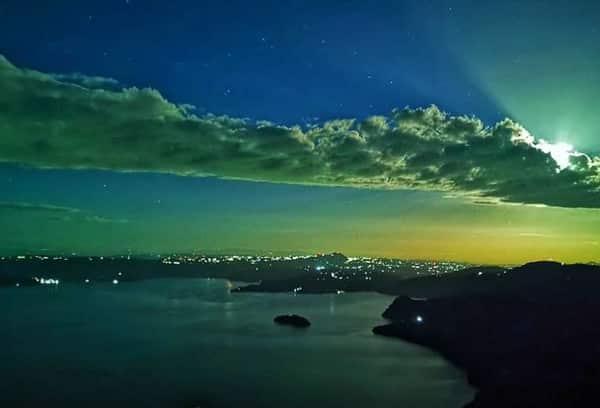
Other Eruptions
Over time, Ilopango’s eruption has formed several lava domes near the shore and within the lake.
The eruptions of 1879 to 1880 formed the Burnt Islets. They serve as a reminder of the history this volcanic crater lake carries with it.
The Burnt Islets also marks the summit of the submerged lava dome formed in the 1879-80 eruptions.

An Active Volcano
Ilopango Lake is an active volcano. Th Fumeroles is a diving location within the lake where divers can feel the warm water rising from the active volcano.
In 2016, researchers from the UK published a report saying that they found evidence that a magma pool is building up beneath Ilopango’s lake.
This evidence suggests that San Salvador, the nation’s capital, might be at risk of future volcanic eruptions. Click here to read the research article. It is an exciting read!
Lake Ilopango El Salvador
Ilopango Lake is a fantastic area to spend the day exploring and relaxing with family or friends. The volcanic caldera has plenty of activities that can be done in a single day.
Ilopango is one of the most popular Salvadoran lakes; also, it is centrally located near the capital city of San Salvador. Take a chance and visit this active volcanic caldera.

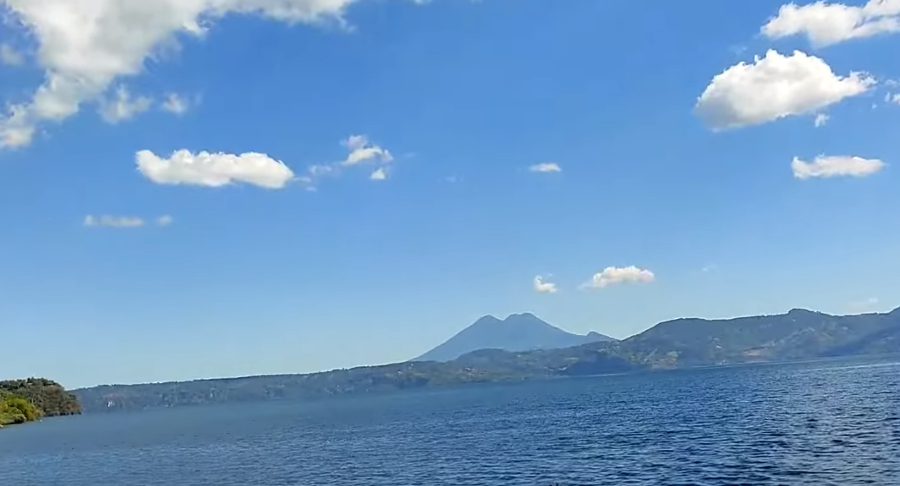 Ilopango Volcano Caldera.
Ilopango Volcano Caldera.



